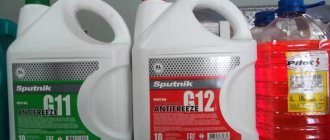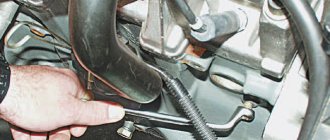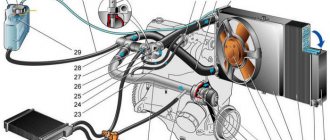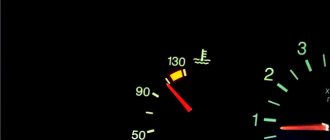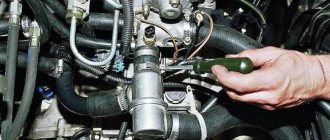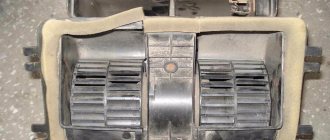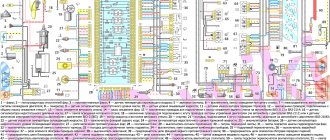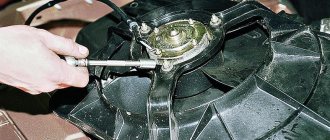To cool the engine in cars, a special liquid called antifreeze or antifreeze is used. The coolant is also used in the VAZ 2114 car and performs the functions of not only cooling the engine, but also heating the vehicle interior.
Many car owners are wondering whether it is necessary to change the coolant and when it should be replaced.
This article talks about replacing the coolant on a VAZ 2114 car, namely the timing of replacement, methods for replacing and flushing the internal combustion engine.
Do I need to change the coolant?
There are a huge number of different opinions about replacing the coolant, but only one of these statements is correct. The coolant definitely needs to be changed, but this can be done much less frequently than changing the same car oil.
The coolant on the VAZ 2114 should be replaced at 40,000 km, but no later than once every five years.
What to do if the car was bought secondhand and it is not known when the last replacement was carried out?
In this case, it is recommended to evaluate the condition of the fluid after purchase and, if necessary, replace it.
Step-by-step draining of coolant from the engine block
You can drain the liquid from the engine block yourself without a pit, performing this process in stages:
- The container for antifreeze or antifreeze must be installed exactly under the block.
- Find the drain plug on the cylinder block and carefully unscrew it. Finding the drain plug is quite simple; this element is located under the car ignition module.
- We wait about 15-20 minutes for the coolant to drain completely, and then screw the plug into its original place.
- Experts recommend thoroughly wiping all drain holes with a clean rag to remove all kinds of dirt.
As you can see, the process of draining fluid from both the radiator and the engine is quite simple, and any car owner can cope with such a task, and without a pit, which is often used for car repairs. And to make replacing antifreeze or antifreeze even easier, a training video on the Internet resource will help, which you can watch at the most convenient time for yourself.
Why change the coolant?
The fluid is replaced due to the loss of its properties of forming various reactions. If you do not change the coolant for a long time, it begins to react with parts of the cooling system, which leads to the formation of rust and can soon destroy parts of the engine cooling system, such as the radiator, thermostat or pump.
How to check what kind of liquid is poured into the cooling radiator
Having bought a car secondhand, you just need to check the presence and level of coolant in the engine cooling system!
Its insufficient level can negatively affect the engine, not to mention the complete absence of fluid in the radiator. It is also worth checking if there are any leaks from the pipes, from the radiator, from the heater in the cabin.
If the old owner of the car forgot to say what liquid was poured into the radiator, you can try to determine its composition yourself. Antifreeze is almost always blue, antifreeze is usually green or red (red comes in different shades, even purple). If the color is unclear (rust color), then this composition must be changed. In general, after purchasing a used car, it is recommended to completely change the coolant.
Mixing liquids with each other
There are two types of cooling fluids: antifreeze and antifreeze. Currently, antifreeze is very rarely used in modern cars; it has been replaced by antifreeze. Antifreeze is less toxic than antifreeze and does not react with aluminum.
Many are tormented by the question of whether it is possible to mix antifreeze and antifreeze with each other; there is no exact answer to this question. But if you accidentally mix antifreeze and antifreeze, nothing bad will happen, but you shouldn’t do this intentionally, but it’s better to pour into the system the liquid that was poured earlier.
What's in it?
So, you purchased a car and don’t know what exactly is in the cooling system. If there is water or already used coolant there, this does not bode well for your engine.
Therefore, first of all, check whether there is any coolant in the engine at all, and what exactly it is. At the same time, make sure there are no leaks from the pipes or radiator.
It is not difficult to independently determine the type of fluid used by the old owner.
- Antifreeze almost always has a blue or blue color.
- Antifreeze is mainly available in red or green. Moreover, there are a huge variety of shades of red.
- It is not difficult to distinguish water from blue or green liquid.
- If the color of the coolant has a characteristic shade of rust, then this indicates the need for urgent replacement.
Green antifreeze
Mixing different coolants. Yes or no?
In some cases, the quality of the fluid is good enough that it is not necessary to replace it. Only the quantity is somewhat below the required level.
Let's say you have antifreeze filled, but you only have antifreeze on hand. What to do in such a situation? Many VAZ 2114 owners are interested in whether it is possible to mix different compounds.
Antifreeze or antifreeze
There is no consensus on this matter. Let us say for sure that a disaster will not occur from mixing, antifreeze and antifreeze will not react and will not explode the car. But we definitely cannot recommend combining two types of coolant in one tank. Follow the instructions in your car's manual, fill in what the factory recommends, and then you won't have any problems.
Antifreeze is simply a type of antifreeze developed in Soviet times for Zhiguli cars. This was done due to the low quality of the antifreeze offered at that time. Since then, antifreeze is the number one choice for VAZ.
Flushing the system
Flushing the system should be done if the coolant has traces of rust, as well as when changing antifreeze to antifreeze and vice versa.
As a washing liquid, you can use special products, distilled or boiled water. It should be noted that chemicals intended for washing SOD do a better job of the task, but their cost is much more expensive than distilled water.
Washing procedure
- It is necessary to drain the old fluid;
- Pour flushing fluid into the system;
- Start the engine and let it run for 30 minutes;
- We drain the liquid; if it has traces of rust and is quite dirty, the procedure must be repeated;
Is it possible to mix antifreeze with antifreeze?
Many people write that it is absolutely forbidden to mix antifreeze with antifreeze. In part this is true, but in part it is not. The fact is that this established stereotype is the result of a marketing ploy. You can mix, but not everything. Antifreeze and antifreeze are based on the same ethylene glycols and other additives. Also, don’t forget the dye. It’s just that if we mix red and blue, we’ll get a dirty brown color, and we won’t see any leaks on the pipe if they appear.
There is a special additional antifreeze labeled G12+. This antifreeze is used as an additional antifreeze, i.e. You can add it to both antifreeze and antifreeze.
G11 <cannot be added> G12, (i.e. cannot be mixed) G12+ can be added to G11 G12+ can be added to G12 G12+ can be added to G12+
1.5 liters of such additional antifreeze cost about 220 rubles. It can be diluted with water to obtain:
- 3 liters of ready-made antifreeze with a freezing point of up to -37;
- 4 liters of antifreeze with a freezing point of -25;
- 5 liters of antifreeze with a freezing point of -15.
It can be diluted with either distilled water or boiled or melted water.
Thus, we answered the following question: Is it possible to dilute antifreeze and antifreeze with water? You can, but keep in mind that by diluting the coolant with water, you lower the boiling point and reduce the freezing point.
Coolant replacement
Replacement should only be done when the engine is cold to ensure safety from burns. Also, before replacing, it is necessary to evaluate what was previously filled.
Determination of previously filled liquid
The first step is to make sure there is liquid in the system. If there is little of it or it is completely absent in the expansion tank, then there is a leak somewhere. Before replacing and adding new coolant, all fluid leaks must be repaired. To do this, we inspect all areas where liquid circulates.
Next, we determine what is flooded.
The car may be filled with: antifreeze, antifreeze and water. All these liquids are different from each other and identifying them is quite simple.
- If the liquid in the expansion tank is red or green, it means there is antifreeze in the system.
- If there is blue liquid in the tank, then the system is filled with antifreeze.
- If the liquid in the expander looks clear, it means it is water.
It happens that due to severe contamination it is difficult to determine what is in the system; in this case, it is recommended to drain the liquid from the system and rinse it. Then fill in high-quality coolant for the cooling system.
It is highly not recommended to fill in water, as it can freeze at subzero temperatures and damage the engine, which, by the way, can lead to serious damage.
Draining liquid
- To drain the liquid, you will need a container with a volume of up to 10 liters. We drain the liquid from the system; to do this, unscrew the cap on the radiator and drain the coolant into a container prepared for this.
- We tighten the plug and, if necessary, do a flush, then drain the flushing liquid again.
- Fill with clean coolant and start the engine.
- The work process is completed.
How to flush the cooling system?
If the car is very old and the cooling system has never been flushed, then there is a risk that if you flush it now, you will clog the radiator, heater core, or thermostat. Also, the use of various types of coolant additives is not recommended, because There is also a risk of clogging the same elements of the cooling system.
- After draining the old coolant, screw all the plugs back into place and fill the tank with distilled water up to the max mark.
- Start the engine and warm it up to operating temperature.
- Let it run for 10 minutes at 2500-3000 rpm. But do not forget to monitor the engine temperature, do not overheat it.
- turn off the engine and let it sit for 6-7 minutes. Then we drain again as we did earlier. We look at the condition of the water: if it is dirty, then we repeat this operation several times until the distilled water is clean.
Useful tips
Replacing the coolant on a VAZ 2114 is not difficult, but it also requires some skills in car repair. The work will be easier and faster, and the result will be much better if you follow the following tips:
- Work must be carried out on a cold engine;
- Before filling in new coolant, it is recommended to flush the system;
- It is not recommended to pour water into the system;
- Before choosing antifreeze and antifreeze, it is best to give preference to antifreeze;
- If you mix antifreeze and antifreeze, nothing will happen, but you shouldn’t do this on purpose;
- After replacing the coolant, it is necessary to warm up the internal combustion engine to operating temperature and check the fluid level, adding fluid if necessary.
How to properly replace antifreeze on a VAZ 2114?
The question of how to replace antifreeze on a VAZ 2114 is resolved in the standard manner. First of all, pay attention to the relevance of these actions. The reason for replacing the coolant may be one of the following factors:
- The service life of the filled antifreeze has expired;
- a leak is detected, the components of the system are repaired or replaced;
- the color of the coolant has changed, foreign impurities have appeared;
- The engine constantly overheats, the antifreeze cannot cope with cooling and gradually boils away.
If during a preventive inspection a low quality coolant is revealed, replacement is carried out with mandatory flushing of the system. It is also relevant if the brand and color of the consumable changes.
When it comes to the frequency of scheduled replacement of antifreeze on the VAZ 2114, they are guided by the service life of the coolant itself. In a car purchased from the manufacturer, it is changed after 60 thousand kilometers . The service life of a replacement consumable is determined by the canister; it is usually 5 years .
When replacing antifreeze on a VAZ 2114, pay attention to certain safety rules :
- all manipulations are carried out with a cooled engine - this avoids thermal burns and high pressure;
- when cooling, the pressure decreases, however, its presence should be taken into account when opening the covers and plugs of the system - splashes and coolant getting on your hands and face are possible;
- antifreeze has a high level of toxicity, it is not allowed to enter the soil; special containers are used to drain coolant and flush water;
- limit the presence of children and animals nearby that can interact with antifreeze.
Taking into account the above factors, the list of tools for replacing antifreeze in the VAZ 2114 includes the following equipment :
- rubber gloves, clean rag;
- a set of keys and screwdrivers, pliers, if possible, a compressor and a pumping bulb;
- drainage container with a volume of 7 liters or more. additional container for rinsing water;
- consumables - new antifreeze, distilled water, optional cleaning agent.
It is also recommended that you first inspect the entire cooling system for worn parts that may soon require replacement. In order not to change the coolant in the near future due to system components, it is recommended to carry out their preventive replacement at the same time as the antifreeze.
All consumables should be purchased only from authorized dealers and trusted suppliers in accordance with the manufacturer’s recommendations for vehicle maintenance. To do this, refer to the technical documentation and identify the original part numbers.
Stage one
Antifreeze is drained from the VAZ 2114 according to the following scheme:
- The car is parked on level ground and, if available, a repair pit or lift is used;
- if the engine has not been running for a long time, it is warmed up for better coolant circulation;
- as additional precautions, remove the minus from the battery, and also cover the generator to prevent antifreeze from getting on it;
- if there is additional engine protection and a protective casing, remove them;
- carefully, taking into account the possible pressure in the system, uncork the radiator and expansion tank caps;
- in the cabin, the heater tap is moved to the right to the maximum to ensure complete drainage of the coolant;
- there is a drain plug in the lower left part of the radiator - place a container under it for draining; before opening it, you should also make sure that the generator is protected from possible ingress of antifreeze;
- to drain the coolant from the cylinder block, you will need to dismantle the ignition module - it is secured with three bolts, the operation does not take much time;
- Place a container under the drain from the cylinder block and unscrew the plug.
Depending on the engine size, about 7 liters of used antifreeze leaks out. To speed up the procedure and ensure complete drainage, some car owners blow out the system with a compressor. Warming up the engine briefly for better circulation also helps. Remains from the expansion tank can be pumped out using a syringe or bulb.
Stage two
To flush the cooling system, use a special product or distilled water. When using the first option, repeated rinsing with water will be required, so many car owners and specialists do not use washing mixtures.
The general washing procedure involves the following stages:
- the lower drains are temporarily tightened, the system is restored to its original form;
- add washing agent or distilled water;
- warm up the engine to operating temperature, turn it off, and allow it to cool;
- drain the rinse in the same way as used antifreeze, repeat the procedure until the water at the outlet remains relatively clean.
Many car owners simplify the cleaning procedure by leaving the bottom drains open and feeding regular water from a hose into the system under medium pressure. This method allows you to avoid constant manipulation of connections and periodic warming up of the engine, but does not guarantee high-quality cleaning of the system.
Stage three
Filling antifreeze for the VAZ 2114 does not have key features that distinguish the process from a similar procedure with other cars. The only nuance is the removal of the coolant supply hose to prevent the formation of air locks.
To replace antifreeze after draining and flushing, the system is returned to its original state and the tightness of the fasteners is checked. After disconnecting the supply hose, new coolant begins to be poured into the radiator. As soon as it flows from the disconnected hose, it is returned to its place.
Next, antifreeze is poured into the expansion tank to the mark indicating the upper limit. Filling is carried out with a thin stream, periodically squeezing the pumping hoses to remove air bubbles.
After filling, screw on the radiator and expansion tank caps, and warm up the engine to operating temperature. The circulation of coolant from the first warm-up will reduce its level in the tank - after the engine has cooled, antifreeze is again added to the maximum.
After 100-200 km, the condition of the coolant should be checked again. Pay attention to the decrease in level - if necessary, add the required amount again and check the system for loose connections and possible leaks. If the color of the new antifreeze has changed, a reddish, brown or black tint has appeared - this is a low-quality product that should be urgently replaced with mandatory flushing of the system.
How to properly drain antifreeze from the cooling system of a VAZ 2114
During engine operation, almost all of its parts are exposed to high temperatures. To cool them in a car, including the VAZ 2114, a special liquid (antifreeze) is used. It circulates through the system and is cooled in the radiator by oncoming air. Used antifreeze must be periodically drained from the tubes and new one filled in.
How to drain
To get started, stock up on all the necessary tools for the job:
- Key;
- screwdriver;
- container for draining;
- new fluid.
If your car has cooled down, then you can proceed to the first part.
- Place the machine on a level surface.
- Open the hood.
- Remove the cap from the tank.
Unscrew the cap from the tank
- Remove the mudguard and unscrew the bolts securing it to the body.
- Place a container for drainage and unscrew all drain plugs.
- Now the liquid can be drained.
Why does it flow
Before you drain the old fluid and change it, you need to understand why it is leaking from your VAZ 2115. Sometimes it is quite difficult to determine. Try to look through all the pipes, there are several places where the element can leak.
- Clamps - they may not be clamped well.
- The pipe itself, which can crack over time.
- Radiator due to mechanical damage.
- A pump or pump that wears out over the years in VAZ cars.
- Leakage from under the head.
- When the leak occurs directly into the car's cabin.
When any type of leak is detected, you first need to repair the area so that this situation does not recur, and then replace it.
When to change?
We have already determined that, from the point of view of the needs of the VAZ 2114, antifreeze is best suited for this car. Although the plant itself has clear recommendations and standards in this regard. If you have a really high-quality antifreeze, which costs more than antifreeze, its performance efficiency will not be inferior to VAZ’s development, and in some places it may even be better.
But first, let’s determine exactly when the coolant needs to be replaced. It all depends on each specific situation, so there are several recommendations in this regard.
- When buying a new car, it should be replaced after every 60 thousand kilometers traveled.
- The standard service life of filled coolant is 2 years. Under normal operating conditions, it is sufficient to change it every two years.
- The coolant must be replaced immediately if its color has acquired a cloudy structure or a rusty tint.
- If the coolant leaked and water was used as a top-up, you need to eliminate the source of the leak and replace all the antifreeze.
- If the engine has been repaired or dismantled, the coolant must be replaced, regardless of its current condition.
What to fill?
A question that interests many is the volume of liquid that should be poured into the engine cooling system of the VAZ 2114. We answer. The volume of antifreeze or antifreeze is exactly 7.8 liters.
Since we agreed that antifreeze would be the best choice, let’s talk about its varieties and determine which one is best to use.
Peculiarities
This antifreeze is a concentrate, so it cannot be poured in its pure form. Diluted with water in proportions of 1 to 1. The freezing point after dilution will be -30 degrees Celsius
Already diluted antifreeze that does not require adding water. The freezing point of the liquid is -65 degrees Celsius
The most common version of antifreeze for the VAZ 2114. Its freezing point is -40 degrees Celsius
Decide for yourself which of this you will pour into the engine cooling system. Each of the three presented types of coolant has its own characteristics and works equally effectively for the benefit of your car.
Do not forget about the existence of high-quality antifreezes. They cost more, but last about 1-2 years longer.
Step-by-step instruction
- Before starting work, open the tap on the stove in the cabin. This is necessary so that during replacement the liquid comes out of the heater radiator.
- Place the car on the pit. Next, unscrew the bolts securing the engine protection and casing. Wrench bolts for “10” and “13”. The location of the bolts is in the photo below.
Close the generator with a bottle and place a container to collect the liquid.
Unscrew the drain on the radiator and make sure that the fluid flows into the collection container.
In order for the liquid to come out faster, unscrew the cap of the expansion tank to allow air in.
Unscrew the bolt marked in the photo below to drain the fluid from the cylinder block cooling jackets. Before unscrewing the bolt, place a container for collection. We also recommend that you do not completely unscrew the bolt in order to collect all the liquid as much as possible.
Tighten the drain bolt on the engine block, as well as the plug on the radiator.
- Insert a funnel into the reservoir and fill the coolant to just above the level.
- Place a container to collect fluid under the hose that goes to the throttle assembly. Next, pressing on the hoses in the places marked below, expel the air from the system.
- Place and secure the hose to the throttle assembly. Next, add fluid to the level and start the engine. After warming up the engine to operating temperature, increase the crankshaft speed in jerks to 2-3 thousand (do this for 20-30 seconds). Stop the engine and let it cool. After cooling, add liquid according to the level if necessary.
The process of replacing antifreeze for VAZ 2113, 2114, 2115 is clearly shown in this video:
Replacement frequency
The manufacturer prescribes three conditions for replacing the fluid (depending on what comes first):
- The coolant is replaced every 80-100 thousand kilometers.
- The fluid needs to be changed every 4-5 years, regardless of mileage.
- If the color of the liquid turns brown, it needs to be replaced urgently. When the fluid loses color, its chemical composition changes, and it has a detrimental effect on the cylinder head and other parts in the cooling system made of aluminum.
Replacement
Now we can talk directly about how the coolant is drained and new antifreeze is added.
We noted that 7.8 liters of antifreeze are required to fill the entire volume of the coolant tank. But it is best to purchase a 10 liter canister. This is useful in case you spill some of the liquid past the neck, and also if you need to top up the coolant over time.
If you carry out the work in a clear sequence, watch preliminary training video instructions, then replacing antifreeze or antifreeze will become an easy task for you.
- Remove the main motor protection. To do this, there are four fasteners under the engine compartment. Although not all cars have protection.
- Remove the protective cover. It is located in front of the body under the engine.
- Unscrew the cap from the expansion tank.
- We climb into the cabin and open the heater tap all the way. This will prevent some of the coolant from remaining inside the system when drained.
- Prepare a container where all coolant from the system will be drained. A basin or other wide dish is better suited so that nothing spills past.
- There is a drain plug on the radiator. You will find it on the lower left, in close proximity to the radiator.
- Don't rush to drain the coolant. First, be sure to protect the generator from antifreeze. To do this, you can wrap it in plastic and put on a bag.
- Now drain all contents from the radiator.

